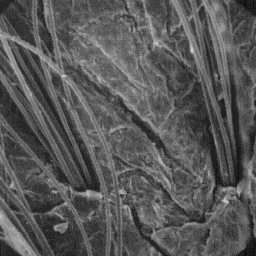 Kolonocus sibiricus
Kolonocus sibiricus
-------------------
English: Siberian weasel, kolinski
German: Kolinsky
French: Kolinski
Spanish: VisĒn de Siberia
Distribution areas
------------------
The Siberian weasel can be found in the
wooded areas of Ural and Siberia, and also
in China and Korea.
Description of the fur
----------------------
The skin is from 30 to 50 cm long, The surface structure
covered with a light brown, yellow-brown or of the skin, 200x
red-brown coat. The difference between the
colouring of the under-fur layer and the upper guard hair layer is not
distinguishable. The length of the majority of the hair fibres is about 20 to
25 mm; the longest guard hairs measure up to 35 mm.
|
|
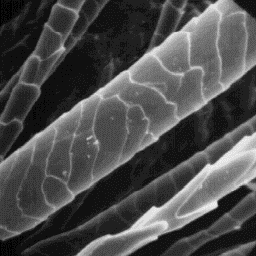 Kolonocus sibiricus
Kolonocus sibiricus
-------------------
English: Siberian weasel, kolinski
German: Kolinsky
French: Kolinski
Spanish: VisĒn de Siberia
Structure of the hair
---------------------
The microscopic structure of the skin
surface appears furrowed. The hair
follicles are narrow with straight edges.
On average, the follicles contain clusters
of about 10 fibres.
The fine fur fibres are circular in A group of hairs of the fine
cross-sectional outline, and are covered and guard type, 2000x
with cornet-like cuticular scales at the
bottom of the shaft but, in the middle and upper parts, the cuticular scales
are petal-like. The surface of the cuticular scales is smooth and the margins
are straight. These fibres have a diameter of 8 to 20 µm. The medulla is
wide, unbroken and symmetrically situated in the central area of the shafts.
The bottom part of the fine fibres is non-medullated. The overall structure
of the medulla belongs to the uniserial ladder type with and amorphous
infilling substance.
|
|
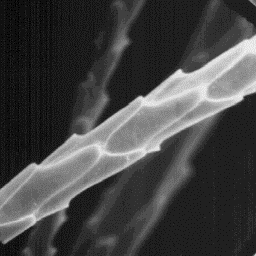 Kolonocus sibiricus
Kolonocus sibiricus
-------------------
English: Siberian weasel, kolinski
German: Kolinsky
French: Kolinski
Spanish: VisĒn de Siberia
The intermediate fibres have a diameter
of 20 to 35 µm. The cross-sections are
circular or ellipsoidal in outline, and the
hair shafts are covered by a cuticle with
wavelike scale. The cuticular surface is
smooth and the scale margins are straight.
The medulla is wide, unbroken and central
symmetrical-shaped. The overall structure
belongs to the uniserial ladder type of The cuticular structure
medulla. The infilling medullar material is of the fine fibres, 1000x
of an amorphous structure.
The guard hairs are circular or ellipsoidal in cross-sectional outline.
The diameter ranges from 60 to 120 µm. The cuticular scales are even
tile-like at the bottom of the shaft but, in the middle, they are wavelike
and, in the upper part, they are crenated tile-like. The scale surface is
smooth and the scale margins are usually straight.
|
|
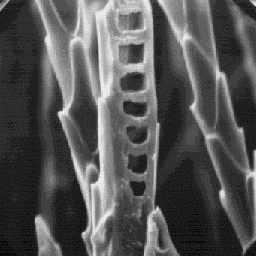 Kolonocus sibiricus
Kolonocus sibiricus
-------------------
English: Siberian weasel, kolinski
German: Kolinsky
French: Kolinski
Spanish: VisĒn de Siberia
The medulla is wide, unbroken and central
symmetrical-shaped in cross-section. The
medulla belongs to the lattice type with a
perforated sheet-like infilling substance
in the medullar column.
Longitudinal section
of a fine fur fibre, 1000x
|
|
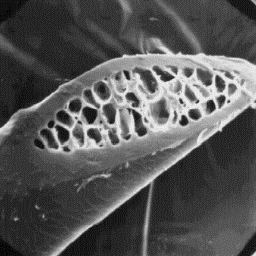 Kolonocus sibiricus
Kolonocus sibiricus
-------------------
English: Siberian weasel, kolinski
German: Kolinsky
French: Kolinski
Spanish: VisĒn de Siberia
Transverse section
of an intermediate fibre, 360x
Numerical code for Siberian weasel skin structure
-------------------------------------------------
Surface of the skin: 3-4-3
Fine fur fibres: 1-5.11-1-1-2-1-1-1-8-8.21-15.25
Intermediate fibres: 1.2-7-1-1-2-1-1-1-8-20.35-18.25
Guard hairs: 1.2-2.7-1-1-2-1-1-8-2-60.121-25.35
|




